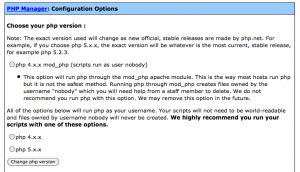Question:
I’d like to change from mod_php to php-cgi. What steps should I take to make sure the change is smooth?
Answer:
Most conversions are as simple as selecting the new version to use in the control panel. If a small amount of possible downtime on your site is acceptable you may want to just try the change and see. In the worst case, you’ll have to wait as long as 15 minutes to switch back to the old version.
The server looks for changes and reloads (if needed) your php configuration every 15 minutes. If you make the change and find you site has problems, you’ll need to “undo” the change by selecting the version you were running previously. You’ll then need to wait for the server to reload your config. Note: During this time your site still runs – there is no downtime – but it does not run the new php version.
If you want near-zero probability of problems (or if you tried the approach above and ran it problems), we recommend the following:
1. Make sure there are no files owned by the generic server user “nobody”. Do this:
find /home/your_user_name_here -user nobody -print
If it shows files owned by nobody, you’ll need to put in a support request for an admin to change the ownership back to your own username.
2. Use the php.ini file that your site was running under before :
mkdir /home/your_username_here/etc/
cp /usr/local/lib/php.ini /home/your_username_here/etc/
4. Make sure date.timezone is set in php.ini. A common problem ugprading to php5.3 is not having date.timezone set. It needs to be set either in your code or (easier) in php.ini
An example for EST timezone is :
date.timezone = 'America/New_York'
5. Check the php.net changelog documentation for any functions that have been removed or changed between the version you are currently running and the version you are upgrading to.

